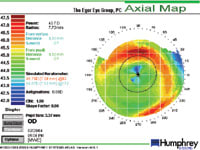readers'
forum
Inadvertent
Corneal Reshaping with Silicone Hydrogel Lenses
BY
MARK W. EGER, OD, FAAO
In December 2003, I attended a lecture at the annual meeting of the American Academy of Optometry in which Patrick Caroline, FAAO, spoke about the corneal reshaping results of a patient who wore a silicone hydrogel lens inside-out for an extended period of time. We also saw a patient who had worn everted silicone hydrogels and experienced similar corneal topographical changes.
Our Case
TB is a 22-year-old Caucasian male who, in November 2002, expressed interest in trying extended wear using a silicone hydrogel lens. His refraction was –7.50DS OU. His simulated K values taken from topography were OD 45.75 @ 82/44.87 @ 172 and OS 45.37 @ 180/45.12 @ 90.
We fit TB with Night & Day (CIBA Vision) silicone hydrogel contact lenses in the following parameters: 8.4mm base curve, –7.00D power and 13.8mm diameter OU, on a 30-day extended wear basis. At his six-month follow-up visit, his vision remained 20/20 in each eye, the fit and mechanics of his lenses were unchanged and his corneas were free of any hypoxia concerns.
|
|
|
|
Figure 1. Topography following everted silicone
hydrogel continuous wear. |
Follow-up Findings
In February 2004, TB presented to our office for his next annual contact lens evaluation. He realized that he was overdue for this exam and expressed concern because the vision in his right eye seemed blurry with his contact lens and his eye was red and photophobic. He wasn't wearing his contact lenses at this presentation. He assured me that he had been compliant with his wear schedule, but had run out of lenses and so used the last pair for two wearing cycles.
Ocular health findings were as expected, with moderate bulbar conjunctival injection OD. We also observed SPK OD, but no other evidence of corneal edema. His refraction was –6.00DS OD and –7.75DS OU with 20/20 corrected vision in each eye. As Figure 1 shows, his corneal topography resembled that of a LASIK or corneal reshaping patient.
Armed with the information I had from the Academy meeting, I dispensed a new pair of trial lenses with the power OD at –6.00D, and his original –7.00D OS. I explained to TB that I felt this finding OD was transient and surmised that he had been wearing his right lens everted for 30 or perhaps 60 days. I also expected that I would have to alter his prescription OD when he returned two weeks later for follow up.
In two weeks, TB returned to the office complaining again of poor vision OD. Both eyes were white and quiet. His lenses weren't everted in either eye. Corrected distance vision OD was now 20/40 as compared to 20/20 when we dispensed the –6.00D lens, and a spherical over-refraction of –1.00D OD produced 20/20 vision. A repeat of his topography revealed no abnormalities in either eye, and closely matched earlier findings from before this incident.
Future Applications?
The obvious question is whether silicone hydrogels have a place in corneal reshaping. I know that investigators are currently looking into this. In the meantime, I am grateful for the knowledge Pat Caroline presented that enabled me to identify the etiology of this patient's problem and resolve it accordingly.
Dr. Eger is in group practice with his son Noah and an ophthalmologist in Coraopolis, PA and currently serves as the secretary/treasurer for the American Academy of Optometry.




